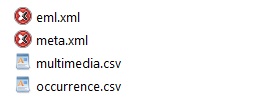Introduction and Specifications
Darwin Core is a metadata standard maintained by the Darwin Core Maintenance Interest Group. The intention of the Darwin Core system is to create a common language for describing biodiversity data. It is a set of terms, which are clearly defined. Essentially it is a set of text (CSV) files with a simple descriptor (meta.xml) to inform others how your files are organized. The format is defined in the Darwin Core Text Guidelines. It is the preferred format for publishing data to the GBIF (Global Biodiversity Information Facility) network (Wikipedia).
If you wish to submit data to Europeana, you will need to provide both a .csv file containing the metadata (occurence.csv) and one containing the links to digital objects that you host on your own server (multimedia.csv). Your Darwin Core Archive should therefore contain at least the following files:

Darwin Core includes a glossary of terms (in other contexts these might be called properties, elements, fields, columns, attributes, or concepts) intended to facilitate the sharing of information about biological diversity by providing reference definitions, examples, and commentaries. The standard is primarily based on taxa, their occurrence in nature as documented by observations, specimens, samples, and related information. Included are documents describing how these terms are managed, how the set of terms can be extended for new purposes, and how the terms can be used. The normative document for the terms [RDF-NORMATIVE] is written in the Resource Description Framework [RDF] and is the definitive resource to understand the term definitions and their relationships to each other. The Simple Darwin Core [SIMPLEDWC] is a specification for one particular way to use the terms – to share data about taxa and their occurrences in a simply structured way – and is probably what is meant if someone suggests to “format your data according to the Darwin Core”.
Additional Material
- Darwin Core (TWDG)
- What is Darwin Core, and why does it matter? (GBIF)
- Darwin Core Terms (Gcube Wiki)
- Darwin Core: An Evolving Community-Developed Biodiversity Data Standard (PlosOne)
Mandatory Fields for Europeana
If you plan to submit Darwin Core metadata to Europeana you need to include these mandatory fields in your DWC Archive:
| (1) dwc:scientificName (Taxon) | (6) dcterms:identifier (Dublin Core – Simple Multimedia Extension) = Direct Link to the digital object on your server |
| (2) dwc:basisOfRecord | (7) dcterms:references (Dublin Core – Simple Multimedia Extension) = Link to the record on your website |
| (3) dwc:catalogNumber | (8) dcterms:rightsHolder (Dublin Core) |
| (4) dwc:institutionCode | (9) dcterms:license (Dublin Core – Simple Multimedia Extension) >> You need to use the URI of one of the available rights statement listed here (CC0, PDM, CC-BY, CC-BY-SA, CC-BY-ND, CC-BY-NC, CC-BY-NC-SA, CC-BY-NC-ND, NoC-NC, NoC-OKLR, InC, InC-EDU, InC-EU-OW, CNE)! |
| (5) dwc:collectionCode | (10) dcterms:type (Dublin Core – Simple Multimedia Extension) |
Recommended Fields for Europeana
We recommend that you fill in as many data fields as possible so that your dataset is easier to understand for a wide audience and the public. It is also much easier to link a well-described dataset to other data in the shared portal. Here are some more data fields that we particularly suggest you use.
| (11) dwc:typeStatus (Identification) | (18) dwc:eventDate (Event) | |
| (12) dwc:decimalLatitude (Location) = Using this field will enable a map view in Europeana | (19) dwc:identifiedBy (Identification) | |
| (13) dwc:decimalLongitude (Location) = Using this field will enable a map view in Europeana | (20) dwc:recordedBy (Occurence) | |
| (14) dwc:locality (Location) | (21) dwc:namePublishedIn (Taxon) | |
| (15) dwc:country (Location) | (22) dcterms:creator (Dublin Core – Simple Multimedia Extension) | |
| (16) dwc:occurrenceRemarks (Occurence) | (23) dcterms:format (Dublin Core – Simple Multimedia Extension) | |
| (17) dwc:occurrenceID (Occurence) | (24) dcterms:language (Dublin Core) |
